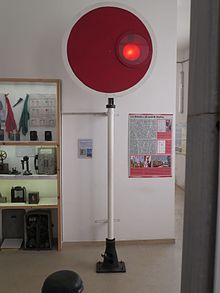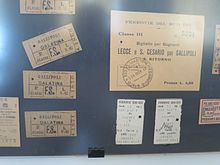Railway Museum of Puglia
The Railway Museum of Apulia ( Italian Museo Ferroviario della Puglia ) in Lecce , Italy , collects and presents objects related to the railway history in Apulia .
Sponsorship
The museum is operated in cooperation between the Associazione Ionoco Salentina Amici Ferrovie (AISAF) and the city of Lecce: The city owns the buildings, the association does the museum work on a voluntary basis . In this respect, the museum only has limited opening times. The museum is located in a former railway depot that Ferrovie dello Stato Italiane (FS) closed in 1992, on the south side of Lecce Central Station. The AISAF was founded in 1997 with the aim of setting up a railway museum. It emerged from a group of railway workers who came together in 1989 to maintain railway culture and model railwaysto build. With the support of the State Railways (FS) and the regional railway company Ferrovie del Sud Est (FSE), work began on setting up the museum in 2010 and was subsequently able to open.
collection
The collection includes both historical vehicles and railway-specific equipment from both the FS and the FSE. This is shown in two exhibition halls, additional exhibition rooms and an outdoor area. The collection of historical railway material is supplemented by some model railway systems that reproduce certain operating situations. One of the installations shows the Castellaneta railway bridges on the Bari – Taranto railway line . In addition, the museum train “Salento Express”, a set of operational historical passenger cars of the FSE, is stationed here, which is used on their network for special trips.
vehicles

There are three (non-operational) steam locomotives in the vehicle fleet : Gr. 905.043 and Gr. 835.244 both from 1911 and formerly used by the FS, as well as the FSE 14 from 1901. The latter is one of two still existing steam locomotives of the FSE (the other is a monument locomotive in Bari ). The FSE 14 is currently being refurbished with the aim of being ready to drive and operational again. The inventory also includes FS electric locomotives , the E.626.033 , E.323.105 and E.324.105 and the FSE BB 159 and 162 diesel locomotives . They are very similar to the D.341 series of the FS and are used today before the "Salento Express".
The diesel railcars from FSE, Ad 06 from MAN , Ad 72 from Breda and various small locomotives from the shunting service are also part of the collection. In addition, a number of passenger and freight cars (mainly from the FSE stock) are on display. A “Cento-Porti-Wagen” deserves special mention among the passenger cars, which was converted into a hospital car during the Second World War , was used on the Eastern Front and was placed on a hospital train of the Italian Red Cross after the war . Interesting special vehicles are a luggage and heating wagon of the FS, which could be provided to trains with insufficient heating power of the locomotives, the only surviving Italian prisoner transport wagon , originally used by the FS, and a water transport wagon of the FSE. The in-house transport of water served remote offices that were not connected to the public water supply network and did not have their own well. They received both drinking and service water (especially for filling the steam locomotives) with their own trains, each of which had its own tank car for drinking and service water .
Technical equipment
In the exhibition rooms that are dedicated to the technical device, among other things, draisines and signal systems are shown. As an example of an electric signal box, the entire workspace of the dispatcher at the FSE station in Zollino has been rebuilt as it was set up in 1963. Machines from the former depot are shown in another exhibition room.

Inscription on the boxcar of the FSE
|
See also
literature
-
Apulia Railway Museum. Illustrated Guide . Cartografica Rosato 2015. Without page counting. In this:
- Francesco Capezza: The AISAF non-profit organization and the Railway Museum , p. [3];
- Paolo Perrone: Railway Museum , p. [2].
- Museo Ferroviario della Puglia . Leaflet, undated
- Pietro Marra: Rotaie a Sud Est . Bagnacavallo 2014. ISBN 978-88-909824-0-8
Web links
Remarks
- ↑ See the lists in: Apulia Railway Museum , p. 13 and Marra, p. 360
- ↑ The FSE, integrated into the FS since August 4, 2016, did not operate any electrified lines. In contrast, all lines operated by the FS were electrified.
- ↑ Description in Italian .
Individual evidence
- ↑ Museo Ferroviario .
- ↑ Capezza; Apulia Railway Museum , p. 4f.
- ↑ Museo Ferroviario .
- ^ Apulia Railway Museum , p. 9.
- ^ Apulia Railway Museum , p. 29ff.
- ↑ Apulia Railway Museum , p. 14.
- ^ Apulia Railway Museum , p. 15.
- ↑ Marra, pp. 357, 359.
- ^ Apulia Railway Museum , p. 16
- ↑ Apulia Railway Museum , p. 17.
- ↑ Marra, pp. 357ff; Apulia Railway Museum , p. 34
- ^ Apulia Railway Museum , p. 18.
- ↑ Apulia Railway Museum , p. 19.
- ^ Apulia Railway Museum , pp. 19, 24f, 27f, 36
- ^ Apulia Railway Museum , pp. 25ff
- ^ Apulia Railway Museum , p. 22.
- ^ Apulia Railway Museum , p. 21
- ^ Apulia Railway Museum , p. 35
- ^ Apulia Railway Museum , p. 37
- ↑ Marra, pp. 330f.
- ↑ Marra, p. 320; Apulia Railway Museum , p. 37
- ^ Apulia Railway Museum , pp. 6, 20, 38f
- ↑ Apulia Railway Museum , p. 7.
- ↑ Apulia Railway Museum , p. 8.
- ^ Apulia Railway Museum , p. 11
Coordinates: 40 ° 20 ′ 39.5 ″ N , 18 ° 9 ′ 59.8 ″ E







